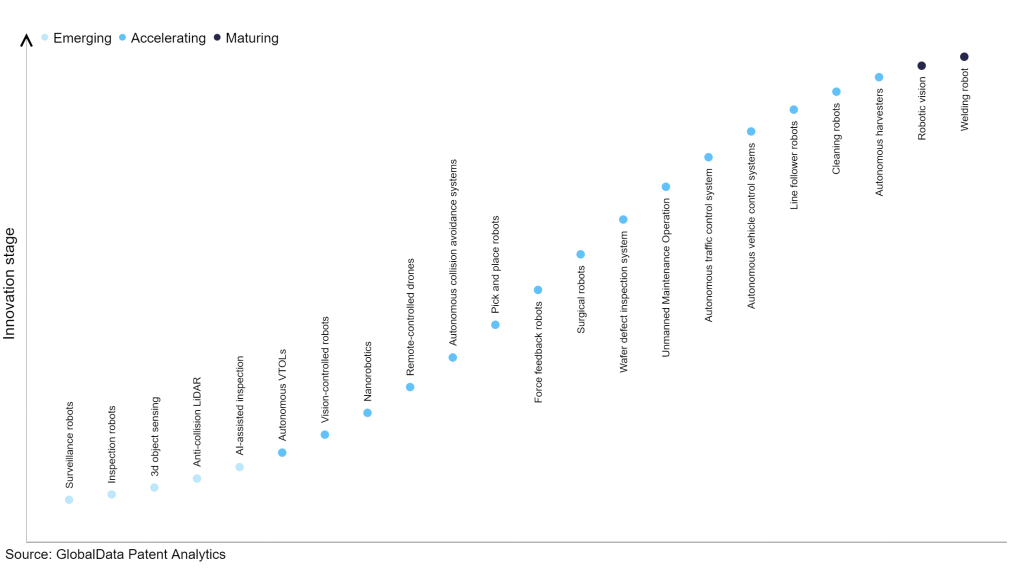The technology industry continues to be a hotbed of innovation, with activity driven by progress in robotics technology, characterised by enhancements in sensors, machine learning, and artificial intelligence, propelling the creation of robots that possess superior capabilities and versatility and growing importance of technologies such as light detection and ranging (LiDAR), radio detection and ranging (RADAR), ultrasonic sensor, and cameras. Autonomous collision avoidance systems can help to reduce traffic congestion by reducing the time needed for accident clean-up and reducing the number of vehicles on the road due to accidents. In the last three years alone, there have been over 3.6 million patents filed and granted in the technology industry, according to GlobalData’s report on Innovation in Robotics: Autonomous collision avoidance systems. Buy the report here.
However, not all innovations are equal and nor do they follow a constant upward trend. Instead, their evolution takes the form of an S-shaped curve that reflects their typical lifecycle from early emergence to accelerating adoption, before finally stabilising and reaching maturity.
Identifying where a particular innovation is on this journey, especially those that are in the emerging and accelerating stages, is essential for understanding their current level of adoption and the likely future trajectory and impact they will have.
300+ innovations will shape the technology industry
According to GlobalData’s Technology Foresights, which plots the S-curve for the technology industry using innovation intensity models built on over 2.5 million patents, there are 300+ innovation areas that will shape the future of the industry.
Within the emerging innovation stage, AI-assisted inspection, anti-collision LiDAR, and 3D object sensing are disruptive technologies that are in the early stages of application and should be tracked closely. Autonomous harvesters, cleaning robots, and line follower robots are some of the accelerating innovation areas, where adoption has been steadily increasing. Among maturing innovation areas are welding robot and robotic vision, which are now well established in the industry.
Innovation S-curve for robotics in the technology industry

Autonomous collision avoidance systems are a key innovation area in robotics
Autonomous collision avoidance systems refer to computer-controlled systems equipped with sensors, cameras, and other devices that can detect obstacles along a vehicle's path and prevent accidents. These systems can also be programmed to direct the vehicle away from traffic or come to a complete stop when an object obstructs its path, providing an added layer of safety to drivers and passengers.
GlobalData’s analysis also uncovers the companies at the forefront of each innovation area and assesses the potential reach and impact of their patenting activity across different applications and geographies. According to GlobalData, there are 100+ companies, spanning technology vendors, established technology companies, and up-and-coming start-ups engaged in the development and application of autonomous collision avoidance systems.
Key players in autonomous collision avoidance systems – a disruptive innovation in the technology industry
‘Application diversity’ measures the number of different applications identified for each relevant patent and broadly splits companies into either ‘niche’ or ‘diversified’ innovators.
‘Geographic reach’ refers to the number of different countries each relevant patent is registered in and reflects the breadth of geographic application intended, ranging from ‘global’ to ‘local’.
Patent volumes related to autonomous collision avoidance systems
Source: GlobalData Patent Analytics
Alphabet is a leading innovator in autonomous collision avoidance systems. The company’s patents are aimed at a vehicle having one or more computing devices that may receive instructions to pick up a passenger at a pickup location and determine when the vehicle is within a first distance of the pickup location. When the vehicle is within the first distance, the computing devices may make a first attempt to find a spot to park the vehicle and wait for the passenger. When the vehicle is unable to find a spot to park the vehicle on the first attempt, the computing devices may manoeuvre the vehicle to make a second attempt to find a spot. When the vehicle is unable to find a spot on the second attempt, the computing devices may stop the vehicle in a current lane to wait for the passenger. The other prominent patent filers in the space include Ford Motor and Intel.
In terms of geographical reach, Tata Motors leads the pack, followed by Sick and Omron Tateisi Electronics. In terms of application diversity, Sick holds the top position, followed by Perceptive Automata and INRIX.
Autonomous collision avoidance systems have the potential to significantly improve road safety and enhance the driving experience for motorists. By using sensors and cameras to detect potential collisions and automatically taking action to avoid them, these systems can significantly reduce the risk of accidents and injuries. This can result in lower insurance costs, reduced downtime for vehicles, and lower medical costs for individuals involved in accidents.
To further understand how robotics is disrupting the technology industry, access GlobalData’s latest thematic research report on Robotics – Thematic Research Report.
Data Insights
From

The gold standard of business intelligence.
Blending expert knowledge with cutting-edge technology, GlobalData’s unrivalled proprietary data will enable you to decode what’s happening in your market. You can make better informed decisions and gain a future-proof advantage over your competitors.






